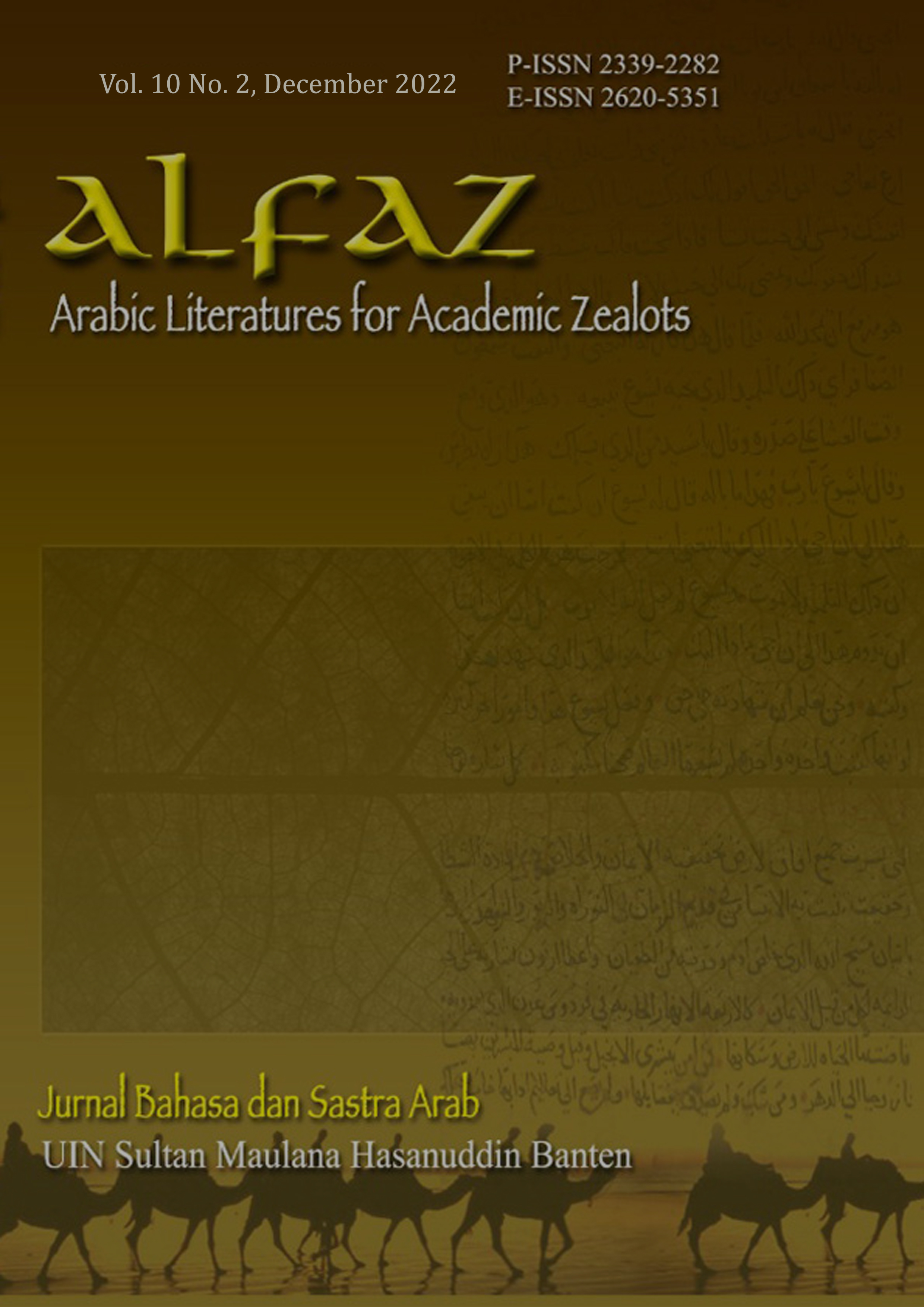Implikasi Teologis Kosakata Mu’arrab dalam Al-Qur’an
DOI:
https://doi.org/10.32678/alfaz.Vol10.Iss2.8468Keywords:
Mu’arrab, Orientalis, TheologicalAbstract
This study aims to explain the theological dimensions that arise due to the presence of non-Arabic vocabulary (mu'arrab) in the Qur'an. Language is a medium in conveying the intentions, needs and goals of its users, both verbally and non-verbally. Language development can follow the cultural evolution of a civilization. It is not surprising that the vocabulary of one language can be found in another language because linguistic changes occur as a result of interactions between speakers of different languages. This research is a library research, using the documentation method, namely by finding and collecting data related to the discussion in this thesis to then be analyzed using the analytical-descriptive method, namely by looking at arguments regarding non-Arabic vocabulary in Al- Qur'an from various experts, both Islamic scientists and orientalists, then the data obtained is analyzed. The aim of this research is to explore mu'arrab in terms of historical, sociocultural and linguistic aspects, and also to prove that non-Arabic vocabulary is natural as a result of the contact between languages and cultures that has occurred. The results of this study indicate that there has been interaction between Arabic and northern Aramia through trade routes, migration and mixing between Aramia and Arabs in the Hijāz. With the mixing between the two languages, then there is language acculturation. Many Arabic vocabularies related to civilization and industry which are loans from Aramia is a very natural thing because it is impossible for the Arabs who are still shrouded in ignorance to recognize these vocabularies.
Downloads
References
Rabi, Abdullah dan Abdul Aziz. Fi Fiqh Al-Lughah. Kairo: Al-Maktabat Al-Tawfiqiyyah, 1976.
Abu Zaid, Nashr Hamid. Tekstualitas Al-Qur’an, Terjemah Mafhûm Al-Nash Dirâsat Fî ‘Ulûm Al-Qur’Ân. Yogyakarta: LKIS, 2005.
Al-Jawaliqi. Al-Mu’arrab Min Al-Kalam Al-A’jami ‘Ala Huruf Al-Mu’Jam. Beirut: Dar Al-Kutub Al-‘Ilmiyyah, 1998.
Al-Suyuthi, Abd. Rahman Jalaludin. Al-Muzhir Fi ‘Ulūm Al-Lughah Wa Anwa’Uha. Kairo: Maktabah Dar Al-Turats, n.d.
Anis, Ibrahim. Fi Al-Lahajat Al-‘Arabiyyah. Kairo: Maktabah Al-Anglo Al- Mishriyyah, 1973.
Armas, Adnin. Metodologi Bibel Dalam Studi Al-Qur’an. Depok: Gema Insani, 2006.
As-Suyuthi, Jalaluddin. “Al-Itqan Fi Ulum Al-Qur’an.” Beirut: Resalah Publisher, 2008.
Baasten, Martin F.J. Aramaic Studies. Leiden: Continuum Publishing Group Ltd, 2004.
Chaer dan Agustina. Sosiolinguistik. Jakarta: Rineka Cipta, 2010.
Geiger, Abraham. What Did Muhammad Borrow From Judaism. New York: Prometheus Books, 1998.
Gusmian, Ishlah. “Lompatan Stilistik Dan Transformasi Dunia Makna Al-Qur’an.” JUrnal Studi Al-Qur’an 2, no. 2 (2007).
Ibnu Warraq. The Origin Of The Koran. New York: Prometheus Books, 1998.
Jeffery, Arthur. The Foreign Vocabulary Of The Qur’an. Baroda: Oriental Institute, 1938.
Katsh, Abraham I. Judaism in Islam: Biblical and Talmudic Backgrounds of The Koran and Its Commentaries. New York: Sepher- Hermon Press, 1980.
Madaniy dan Ilyas. Mengungkap Rahasia Al-Qur’an. Bandung: Mizan, 2009.
Manshur, Munjid Sayyid Ahmad. Ilmu Al-Lughah Al-Nafsi. Riyadh: Jami’ah al-Mulk Su’ud, 1982.
Rippin, Andrew. Syrian in The Qur’an: Classical Muslim Theories. Milton: Routledge, 2007.
Ritonga, Jago. “Arabisasi Dan Perspektif Bangsa Arab Terhadap Bahasa Asing.” Innovatio 6 (2007).
Shaban, Sahil. Mu’jam Al-Alfadz Al-Lughat Al-Arabiyyah Fi Al-Lughah Al-Turkiyyah. Riyadh, 2005.
Sirhaan, Muhammad. Ilmu Bahasa Arab. Semarang: IKIP Semarang Press, 1956.
Syathibi. Al-Muwafaqat. Beirut: Dar Al- Ma’rifah, 1997.
Velayati, Ali Akbar. Ensiklopedia Islam Dan Iran: Dinamika Budaya Dan Peradaban Islam Yang Hidup. Jakarta: PT. Mizan Publika, 2010.
Wafi, Ali Abdul Wahid. Fiqh Lughah. Kairo: Nahdhah Mishr, 2004.
Ya’kub, Emil Badi’. Fiqh Al-Lughat Al-Arabiyah Wa Khashaisuha. Beirut: Dar Al-Tsaqafah Al-Islamiyah, 1982.
Zuhriah. “Eksistensi Kata Serapan Dalam Al-Qur’an.” Jurnal Ilmu Budaya 4, no. 1 (2016): 64–71.
Downloads
Published
Issue
Section
License
Copyright (c) 2023 Mufrodi Mufrodi, Zaki Ghufron, Nasrullah Nasrullah, Lukmanul Hakim, Nikmatullah Kusni

This work is licensed under a Creative Commons Attribution-NonCommercial-ShareAlike 4.0 International License.
Authors retain copyright and grant the journal right of first publication with the work simultaneously licensed under a CC BY NC SA License that allows others to share the work with an acknowledgement of the work's authorship and initial publication in this journal.







